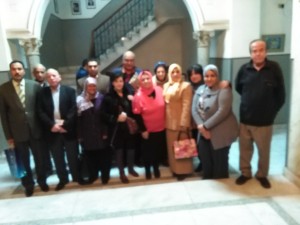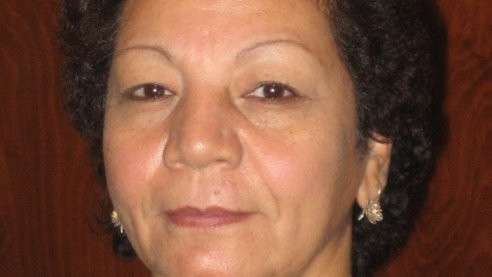Ahram Weekly April 1999
Al-Bashmouri , Salwa Bakr
Reviewed by Ibrahim Fathi
Salwa Bakr's latest novel raised a considerable controversy on its appearance, attacked by some of its readers even before being published in its entirety. The attack focused on the novel's presentation of 9th century AD (3rd century AH) post-Islamic Egypt: its most vehement critics appearing to believe, mistakenly, that the period dealt with in the novel was an extension of the Golden Age of the Rightly Guided Caliphs. Some critics even went so far as to imply that the novel's chief preoccupation was with the persecution of Egyptian Copts during that period, a reading both unfair and reductionist.
At the heart of the novel is the Bashmouri Revolt, an uprising in the marshlands north of the Delta during the reign of the Abbasid Caliph Al-Ma'mun, whose wali (governor) was ruthless in levying the kharaj land tax. Nowhere does the novel depict this revolt as specifically Coptic -- indeed, it included among its ranks many Muslims from Arab tribes who had themselves led a number of uprisings in protest against the kharaj. Many of these migrant, originally nomadic tribes had settled in Egypt, worked in agriculture and suffered the same oppression faced by Egyptian peasants, regardless of whether they remained Copts or converted to Islam, and the novel makes no bones about the anger of the Caliph in Baghdad at the havoc wreaked by Egypt's wali, who failed to report deteriorating conditions to Baghdad until things had got out of hand.
The novel's main protagonist, a Coptic deacon, speaks on several occasions of the welcome accorded to the Muslims when they came to Egypt, emphasising the desire of the Copts to be rid of Byzantine rule. He also praises the Prophet Mohamed and the early Muslim rulers who, unlike their Byzantine predecessors, were just to the natives.
On a more general level, the novel deals with the stance of the Coptic Church vis-a-vis the Bashmouri Revolt. In the opinion of the Church, the revolt threatened to tear the country apart, and offered an opportunity to Byzantium's allies, the Malakites, to once again seize power in Egypt, a scenario which would have spelt doom for the Coptic Church. Prayers had already been Arabised by Coptic patriarchs concerned that, following the adoption of Arabic by much of the congregation, devotions were being conducted in a language few could understand.
Al-Bashmouri seeks to present, simultaneously, both a historical document and narrative structure. It places under the microscope a turbulent historical period fraught with seemingly irreconcilable ideological, social and political conflicts. And it is the nature of these conflicts, together with the impossibility of reaching compromise, that informs the novel's tragic ending.
At the centre of the novel is the odyssey-like journey of the two protagonists, who tread a bewilderingly twisted path through the intractable marshland that constitutes the history of their time. It was a time that provided few if any signposts as reality became increasingly intolerable.
The characters who bear witness to this journey are a complex, multi-faceted lot whose very contradictions allow them to mediate between the historical/documentary dimension of the novel and its fictional structure. It is through the church custodian, who cleans the floor, kneads the dough and bakes the bread that is then consecrated, that we first learn about Deacon Thawna, the character who must convey to the rebels the concern of the Church and its plea that they lay down their arms and pay the kharaj to the wali. Yet the Bashmouri rebels have already embarked on a journey of no return. The levying of the tax left hundreds of them hungry. Children were sold. Families survived by eating grass and worms. Insanity stalked the land. And an army had already departed Baghdad to crush the rebellion.
Deacon Thawna is depicted as something of a Renaissance man. A student of old Egyptian and Hellenistic teachings, familiar with arithmetic, astronomy, philosophy, alchemy and physiognomy as well as with the heresies and pagan beliefs the people had not yet completely given up, he had also learned painting and folk medicine from an elderly woman who clung to her pagan beliefs.
It is the lessons learned from this woman that save Thawna when he is bitten by an asp. As he falls in delirium Thawna invokes the name of Hermes, messenger of the gods and himself the Greek god of forging and invention, together with the name of his teacher whom he says was blessed by the mother of all gods, Isis.
Thawna's hallucinations serve to show the contradictory belief systems that have contributed to his making, contradictions that are reinforced when he recovers from his hallucination to explain his earlier agnosticism and far from doctrinaire position on carnal pleasure. He is, then, a veritable humanist, at once a man of the Church and a scholar who knows Coptic, Greek and Arabic, science, icon painting and portraiture.
During his long journey with the custodian of the church Thawna is exposed to the destitution of the people and witnesses how some members of Arab tribes have turned into bandits, operating beyond the wali's control, attacking the peasants and threatening to attack the monastery. And as the novel unfolds it becomes patently clear that the peasant revolt will be crushed and all those captured -- men, women or slaves -- will be taken to Baghdad after their villages have been pillaged and burned. The final procession of the captives is watched by a mob which salutes the victor and curses the vanquished.
The journey has come to an end and deacon and custodian part. Later, in a dream, the deacon appears to the custodian dressed in rags, standing atop a hill in the distance, as if a saint, blessing with his raised hand the custodian who is encircled by fierce animals. It is almost certain that in the second part of this novel -- yet to be written -- we will encounter them again. As for the first part, it ends with the custodian losing his ecclesiastical robe and being enslaved. His last news of Thawna is from a stranger who tells him that he met his travelling companion, still dressed as a priest but insanely raving.
The novel is both a navigation within the self and an excavation of a history not of the powerful but rather one synonymous with the human condition. Al-Bashmouri delves into the lowest strata, documenting what takes place during a period of crisis in which ordinary people fail to make a common cause. The two protagonists are constantly transforming as a result of their struggle with reality and the self.
Salwa Bakr obviously intended her novel to appear as a resuscitation of history rather than a historical fiction and has succeeded in presenting a seemingly disinterested testimony. In doing so, though, she has perhaps over-burdened the novel with period details spanning heresies, rites, drugs and even furniture. This said, she has successfully avoided the trap into which many historical novels fall, deftly negotiating the contradiction between the archaeological, museum-like frame and the contemporary psychological prism through which today's readers perceive the world.
Ibrahim Fathi reviews Salwa Bakr's novel Bashmouri
Time travellers
By: Ibrahim Fathi - on: Wednesday 1 October 2003 - Genre: Book Reviews
Upcoming Events

Arabia Felix - Alarabia Alsaida in Bayt Yakan
April 15, 2025
Arabia Felix by Thorkild Hansen, and translated by...

A writer, a vision, a journey: a conversation with Professor Ilan Pappe
March 15, 2025
This event took place on 15 March, 2025 . You may...

مسافر يبحث عن ماء
February 17, 2025
تقيم نقابة اتحاد كتاب مصرشعبة أدب الرحلات تحت رعاي...

Online discussion of The Vegetarian by Han Kang Nobel Prize winner 2024
November 08, 2024
This discussion of Han Kang’s The Vegetarian...
